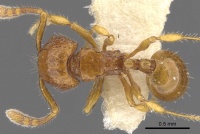Pristomyrmex longus
| Pristomyrmex longus | |
|---|---|

| |
| Scientific classification | |
| Kingdom: | Animalia |
| Phylum: | Arthropoda |
| Class: | Insecta |
| Order: | Hymenoptera |
| Family: | Formicidae |
| Subfamily: | Myrmicinae |
| Tribe: | Crematogastrini |
| Genus: | Pristomyrmex |
| Species: | P. longus |
| Binomial name | |
| Pristomyrmex longus Wang, M., 2003 | |
This species has been collected in lowland rainforest.
Identification
Wang (2003) - Worker. Masticatory margin of mandible lacking a diastema and possessing four teeth, of which the third tooth, counting from the apex, smallest; eyes small, with only two to three ommatidia in the longest row; dorsum of petiole node in dorsal view long-oval and longer than broad; first gastral tergite with numerous hairs.
The workers of P. longus are quickly recognizable by the following: In the levigatus group, only three species, [Pristomyrmex boltoni, Pristomyrmex coggii, and Pristomyrmex longus, possess small eyes. Only two species, P. longus and P. obesus, have numerous hairs evenly distributed on the entire first gastral tergite. But in only one species (P. longus ) is the dorsum of the petiole node in dorsal view long-oval and longer than broad; in the other members of the levigatus group, the dorsum of petiole node is subrounded or transverse-oval (i.e., about as long as broad or broader than long).
A member of the Levigatus species group
Keys including this Species
Distribution
Latitudinal Distribution Pattern
Latitudinal Range: -6.733329773° to -6.733329773°.
| North Temperate |
North Subtropical |
Tropical | South Subtropical |
South Temperate |
- Source: AntMaps
Distribution based on Regional Taxon Lists
Indo-Australian Region: New Guinea (type locality).
Distribution based on AntMaps
Distribution based on AntWeb specimens
Check data from AntWeb
Countries Occupied
| Number of countries occupied by this species based on AntWiki Regional Taxon Lists. In general, fewer countries occupied indicates a narrower range, while more countries indicates a more widespread species. |

|
Estimated Abundance
| Relative abundance based on number of AntMaps records per species (this species within the purple bar). Fewer records (to the left) indicates a less abundant/encountered species while more records (to the right) indicates more abundant/encountered species. |

|
Biology
|
Castes
Known only from the worker caste.
Nomenclature
The following information is derived from Barry Bolton's Online Catalogue of the Ants of the World.
- longus. Pristomyrmex longus Wang, M. 2003: 502, figs. 219-220 (w.q.) NEW GUINEA.
Unless otherwise noted the text for the remainder of this section is reported from the publication that includes the original description.
Description
Worker
Holotype. TL 2.51, HL 0.67, HW 0.66, CI 99, SL 0.55, SI 83, EL 0.07, PW 0.44, AL 0.66. Workers. TL 2.22-2.68, HL 0.63- 0.70, HW 0.62-0.70, CI 95-100, SL 0.52-0.56, SI 80-87, EL 0.05-0.10, PW 0.40-0.46, AL 0.60-0.70, PPW 0.17-0.18, PPL 0.16-0.16, PPI 104-113 (n = 15).
Mandibles usually smooth and shining. A broad-based short tooth present about midway on the basal margin of the mandible. Clypeus flat, its anterior margin with a median tooth and two lateral teeth; sometimes the median tooth is weak. Frontal area concave, with a median carina that usually extends to the clypeus. Ventral surface of clypeus smooth, lacking any rugae or prominences. Palp formula 1,3. Frontal carinae distinct, extending to the level of the posterior margins of eyes. Scrobal impressions shallow, smooth, present lateral to the frontal carinae. Frontal lobes weakly expanded. Antennal scapes, when lying on the head, dose to the occipital margin. Eyes very small, consisting of 4 to 10 ommatidia, with only two to three ommatidia in the longest row. Occipital margin straight or feebly concave in full-face view. Pronotum unarmed. Propodeum with a pair of triangular teeth. Metapleural lobes rounded. Petiole node in profile high with the anterodorsal angle higher than the posterodorsal, its anterior face subparallel to the posterior one; anterior peduncle of the node about as long as or slightly shorter than the node; subpetiole with a narrow semitranslucent lamella. In dorsal view, dorsum of petiole node long-oval and distinctly longer than broad. Postpetiole in profile rounded dorsally, in dorsal view slightly broader than long or about as long as broad. Dorsum of head between the frontal carinae mostly smooth but usually with some sparse, small, and shallow punctures. Some foveolate punctures present on the genae and around the occipital corners of head. Dorsum of alitrunk, petiole, postpetiole, and gaster usually unsculptured, smooth, and shining. Dorsal surfaces of head, alitrunk, and gaster with numerous erect to suberect hairs. Two pairs of hairs usually present on the dorsal surfaces of petiole node and postpetiole, respectively. A few pairs of forward-projecting hairs present near the anterior clypeal margin. Scapes and tibiae with numerous erect to suberect short hairs. Color yellow-brown to reddish-brown.
Type Material
Holotype Worker. Museum of Comparative Zoology. New Guinea: Huon Pen., Lowe r Busu R., lowl. rainfor., 5.v.1955, #957 (E. O. Wilson). Paratypes.14 workers (MCZC, Australian National Insect Collection, The Natural History Museum). Eight workers with same data as holotype; one worker, New Guinea: Huon Pen., Lower Bush R., lowland rainforest, 6.v.1955, #978 (E. O. Wilson); five workers, New Guinea: 13 km NW Lae, Bubia, lowland rainforest, 26.iii.1955, #688 (E. O. Wilson).
References
- Wang, M. 2003. A Monographic Revision of the Ant Genus Pristomyrmex (Hymenoptera:Formicidae). Bulletin of the Museum of Comparative Zoology 157(6): 383-542 (page 502, figs. 219-220 worker described)
References based on Global Ant Biodiversity Informatics
- CSIRO Collection
- Janda M., G. D. Alpert, M. L. Borowiec, E. P. Economo, P. Klimes, E. Sarnat, and S. O. Shattuck. 2011. Cheklist of ants described and recorded from New Guinea and associated islands. Available on http://www.newguineants.org/. Accessed on 24th Feb. 2011.
- Wang M. 2003. A Monographic Revision of the Ant Genus Pristomyrmex (Hymenoptera:Formicidae). Bulletin of the Museum of Comparative Zoology 157(6): 383-542.
- Wang M. 2003. A monographic revision of the ant genus Pristomyrmex (Hymenoptera:Formicidae). Bulletin of the Museum of Comparative Zoology 157(6):383-542

